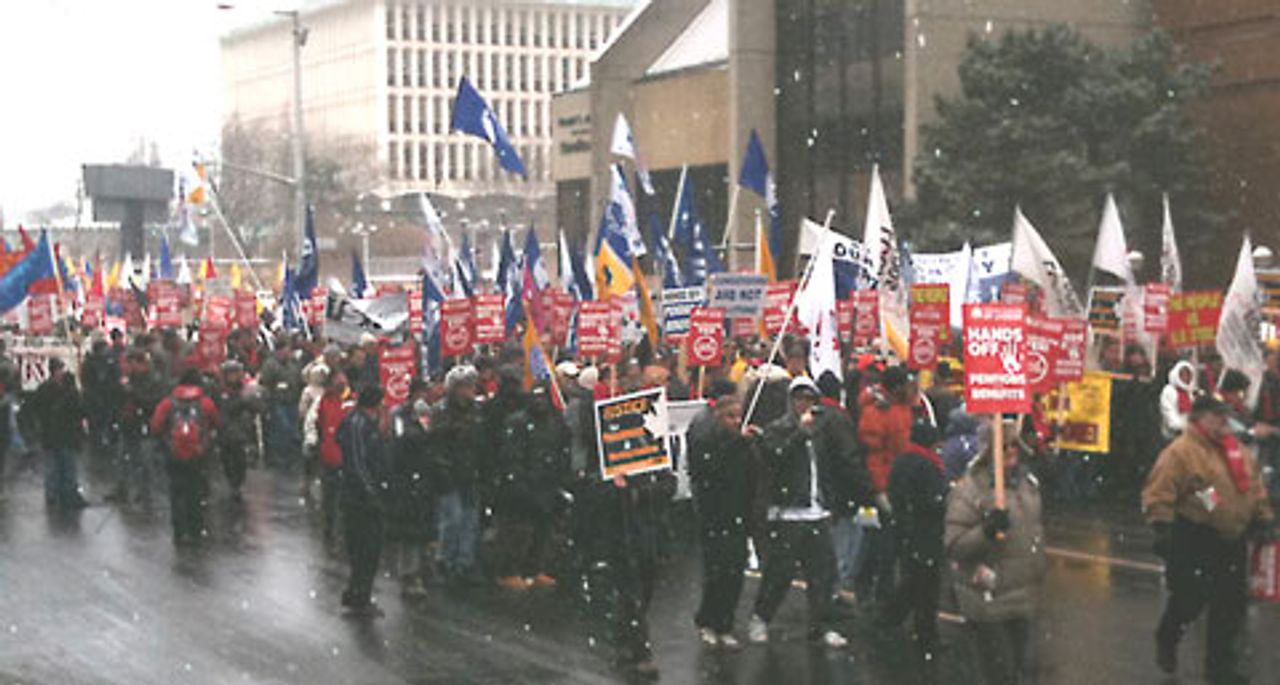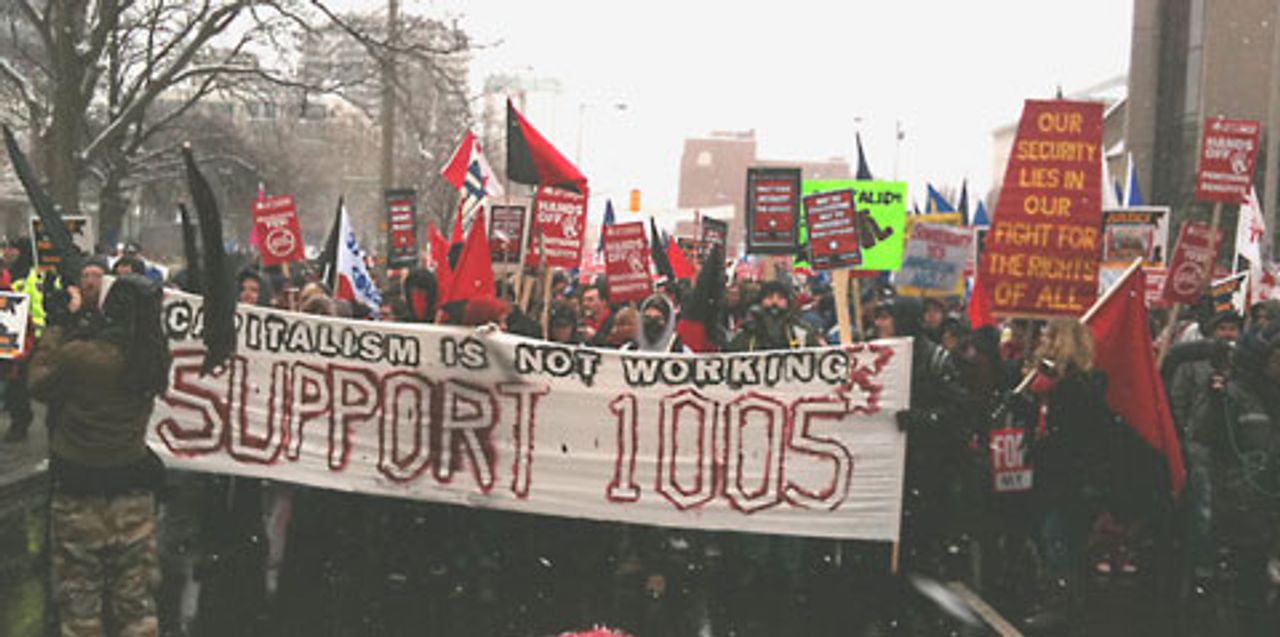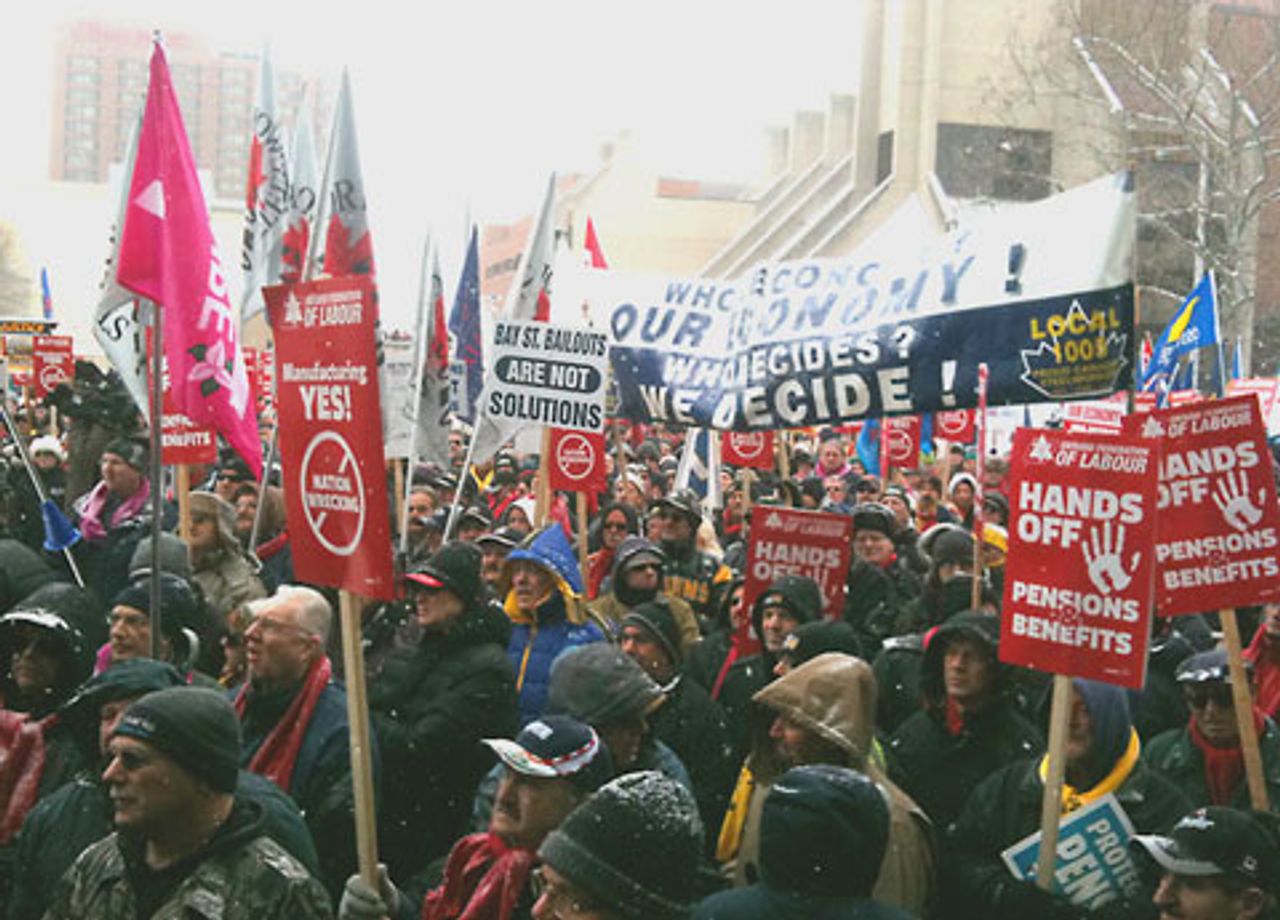 Following the rally at city Hall, close to 10,000 workers, pensioners and students march through the streets of Hamilton in solidarity with locked out Steelworkers
Following the rally at city Hall, close to 10,000 workers, pensioners and students march through the streets of Hamilton in solidarity with locked out SteelworkersAbout 10,000 people marched through downtown Hamilton, Ontario last Saturday to show their support for 900 workers who have been locked out for 11 weeks by US Steel at the (former Stelco) Hilton Works complex. The rally was called by the Ontario Federation of Labour (OFL) to protest deepening attacks on workers’ pension schemes, not only at US Steel-Stelco, but across Canada.
The rally was attended by workers and retirees from many United Steelworker-organized mills, mines and factories, including Vale Inco, and by auto workers, public sector workers and young people.
Since 1983 company-provided pension coverage for workers in Canada has dropped from an average of 40 percent to less than 35 percent of personal income. For those without any private pension—that is, the majority of the population—the federal government’s Canada Pension Plan (CPP) covers, at most, just 25 percent of a worker’s former income. Since the global collapse of the financial system in 2008, employers have sought to buttress their profit levels by divesting themselves of their previous pension responsibilities.
In the current dispute at US Steel, management is seeking to impose a two-tier pension plan on the remaining members of Local 1005 of the United Steelworkers (USW) union as well as other concessions. Since the company bought Stelco in 2007, 2,200 jobs have been shed, whilst those workers continuing in employment have suffered through extensive periods of layoff. The sacking of the 2,200 workers was pushed through by US Steel in apparent violation of agreements with the federal government undertaken by the company when it purchased Stelco. That dispute is currently before the courts.
The existing defined benefits plan at the Hamilton works—under which retirees are guaranteed a set pension—would be closed to new hires and replaced with a defined contribution scheme that places an employee’s retirement at the mercy of stock market fluctuations. Management is also insisting that the pension entitlements of over 9,000 retirees be de-indexed from a cost-of-living allowance that protects the pensioners from inflation.
But if workers at the rally were looking for a viable way forward in the fight for a decent retirement, they were to be sorely disappointed. The speakers’ podium at the rally was dominated by leading figures from the labour bureaucracy—among them Sid Ryan, president of the OFL, Ken Georgetti of the Canadian Labour Congress (CLC), Leo Gerard, president of the USW, and Ken Neumann, the Canadian National Director of the steelworkers’ union.
The cynicism and impotence of these figures was on full display throughout their speeches. International Steelworkers leader Leo Gerard bombastically declared that he would “be damned” if he allows a two-tier scheme to be foisted on the Hamilton membership. Gerard must believe that Steelworkers’ memories are extremely short. Only last year, two-tier pension schemes were imposed on Steelworkers at the Vale Inco mines in Sudbury and at U.S. Steel’s Lake Erie works, which lies only a few miles from the current idled Stelco facility. And in Labrador, Newfoundland, the USW is this week recommending that Vale Inco workers accept similar concessions after a year-and-a-half on the picket lines.
 A section of the march in downtown Hamilton with signs denouncing capitalism and in support of locked out United Steelworkers union (USW) local 1005
A section of the march in downtown Hamilton with signs denouncing capitalism and in support of locked out United Steelworkers union (USW) local 1005In their speeches, the OFL, CLC and other union leaders made various appeals to the federal government of Conservative Prime Minister Stephen Harper. Intoned Sid Ryan, “We’re saying to the Canadian government, force this company to live up to the commitments they made to Canadians.” Should one of the most pro-big business governments in the history of the country fail to listen to Ryan’s slavish appeal, he promised to make pensions “an issue” in the next federal election.
CLC leader Ken Georgetti made clear exactly what this will mean, calling on the assembled throng to support “our NDP Members of Parliament.” In this regard, Georgetti chose his words quite carefully. In past elections, trade union leaders have called for the re-election of the handful of sitting NDP members, while promoting “strategic voting” schemes that encourages workers to vote for the big business Liberal opposition wherever the NDP is trailing in the polls.
To underline this approach, the OFL deigned it “politic” to exclude leaders of the federal and provincial NDP from the speakers’ list. In any case, the NDP itself—whenever it has gained power in provincial legislatures—has consistently pursued pro-business policies. And, with the full support of the CLC, OFL, and USW leaders, it responded to the eruption of the world economic crisis in the fall of 2008 by immediately striking a deal to serve as the junior partner in a Liberal-led coalition government.
At the rally, a handful of supporters of the Communist Party of Canada circulated a statement calling for the “nationalization” of the Stelco works. But “nationalization” for this nationalist-Stalinist group is to be accomplished, not by a workers government, but by the very big business parties that currently predominate in parliament. For these remnants of counter-revolutionary Stalinism, the “nationalization” of the steelworks is necessary in order to better arm Canadian-based companies to wage trade war against their competitors in other countries—at the expense of workers in the US, Europe and Asia, as well as those in Canada
Also present at the demonstration and promoting their ultra-nationalist call for “Canadian sovereignty” were members of the Communist Party of Canada (Marxist-Leninist). Rolf Gerstenberger, the president of the locked-out Local 1005, is vice-president of the Maoist group. Since the beginning of the lock out Gerstenberger has functioned as a loyal member of the USW bureaucracy, depicting the struggle primarily as one between Americans and Canadians—not workers and capital—and actively opposing a joint struggle of steelworkers in North America and around the world against all concessions and job cuts. Like the other USW leaders, he cannot and will not make any appeal to US Steel’s American workforce to take job action in support of their brothers and sisters in Hamilton.
 Workers from across southern Ontario gather at Hamilton City Hall in support of locked out Steelworkers
Workers from across southern Ontario gather at Hamilton City Hall in support of locked out SteelworkersUS Steel’s wholesale attack on its workers’ retirement plan is part of an employer offensive that has seen companies across the country gut pension plans that were won through decades of struggle. Corporations have been pushing for the institution of defined-contribution plans in place of defined-benefit plans because the former greatly limit their future liabilities. Under such schemes, companies are required to regularly pay defined amounts for their workers’ pension benefits into investment vehicles, but all the risk then falls on the workers. Companies are freed from any obligation to set aside monies for a “rainy day” should pension investments go sour. Defined-contribution schemes thus improve companies’ capital base and make them more attractive to buyers in any takeover scenario, driving up the value of their shares.
Last month, the federal Conservative government reneged on a commitment to raise Canada Pension Plan benefits and in concert with the provinces adopted a scheme supposedly aimed at solving the pension crisis that was designed for and by big business. The new pension scheme will provide workers with not a cent in defined benefits, makes the administration of the scheme a new source of enrichment for the financial industry, and places workers’ retirement income entirely at the mercy of the gyrations of the stock market
Supporters of the Socialist Equality Party intervened at the Hamilton rally, circulating a leaflet denouncing the duplicity of the labour bureaucracy and calling for an internationalist program to defend workers’ livelihoods.
The leaflet concluded, “If the Hamilton US Steel workers’ struggle is not to be isolated and defeated, workers must repudiate the nationalist, pro-capitalist perspective of the USW and the NDP. The Hamilton US Steel workers must strive to make their struggle the spearhead of an industrial and political counter-offensive of the entire working class against the drive of big business and their governments to make working people pay for the world capitalist crisis. They must take the leadership of their struggle out of the hands of the bureaucracy, form their own rank-and-file strike committees, and consciously strive to unite their struggle with steelworkers and all other workers in the US and around the world.”
“Militant industrial action, including the organizing of mass picketing and solidarity strikes, must be coupled with the development of an independent political movement of the working class that fights for a workers’ government committed to reorganizing economic life on socialist lines so production and employment can be based human need, not the profits of the few.”
This author also recommends:
Canada: Steelworkers’ struggle at a crossroads
[31 January 2011]
Subscribe to the IWA-RFC Newsletter
Get email updates on workers’ struggles and a global perspective from the International Workers Alliance of Rank-and-File Committees.
